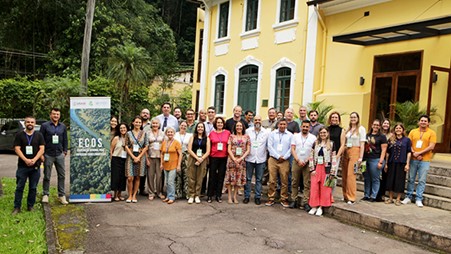
Rio de Janeiro, 4 December 2023 – Aiming to share national and international experiences and advance the improvement of timber identification field techniques to tackle forest crimes, the United Nations Office on Drugs and Crime (UNODC) held a regional workshop at the Botanical Garden in the city of Rio de Janeiro (RJ) from 28 to 30 November, bringing together representatives of public research institutes, academia, and institutions working in environmental law enforcement.
The activity was held as a part of ECOS - Regional Cooperation to Address Environmental Crimes project, a partnership between UNODC and the United States Agency for International Development (USAID), with the support of the Laboratory of Forest Products of the Brazilian Forest Service (LPF/SFB), the Rio de Janeiro Botanical Garden Research Institute (JBRJ), and the Itapeva Technological Innovation Centre (CITI), linked to São Paulo State University (Unesp).
During the workshop, an expert consultant presented the results of a study carried out by UNODC to initiate the creation of databases of images and near-infrared spectra of 15 key species of native wood in national and international trade and/or listed in the appendices of the Convention on International Trade in Endangered Species of Wild Fauna and Flora (CITES). Among the species selected are jatobá, cedar, ipê-amarelo, maçaranduba, itaúba and mahogany.
The database will be used to improve algorithms used in timber identification, with the ultimate goal of allowing for the creation of a more effective tool for use in the field by law enforcement and environmental inspection agents. Such a tool would strengthen the response of these institutions for illegal logging, as well as contribute to the construction of more robust evidence for criminal investigations related to environmental crimes.
At the opening of the event, Natália Milanezi, coordinator of the ECOS project, Fernando Gouveia, coordinator of the LPF/SFB, and Leonardo Salgado, director of Scientific Research at JBRJ, emphasized the importance of inter-institutional work to join forces in developing more effective identification technologies that can be applied in the field.
Initiatives in progress
During the event, the LPF/SFB presented the different identification techniques supported by UNODC’s initiative, including image identification and near-infrared spectroscopy (NIRS) identification. In addition, the JBJR presented the institution's research initiatives, and CITI/Unesp presented the methodology that will be applied to improve the algorithms.
The xylotheques of Embrapa Amazônia Oriental, the Institute for Technological Research (IPT), the Institute for Environmental Research (IPA), and the Emilio Goeldi Museum of Pará, which provided samples used in the consultancy to create the database, also presented their work.
In addition to the national institutions, representatives from Peru's National Forestry and Wildlife Service (SERFOR) and the Centre for Productive Innovation and Technological Transfer of Wood (CITEmadera), Colombia's Ministry of the Environment and Sustainable Development, and Ecuador's National Biodiversity Institute (INABIO) also presented their institutions' initiatives on the subject, exchanging experiences and mapping out possibilities for cooperation with Brazil.
Representatives from the Federal Police's National Criminalistics Institute (INC/PF), the Brazilian Institute for the Environment and Renewable Natural Resources (Ibama), the Chico Mendes Institute for Biodiversity Conservation (ICMBio), the University of Brasilia (UnB), the State University of Campinas (Unicamp), the National Council of Public Prosecutors (CNMP), the National Institute of Metrology, Quality and Technology (Inmetro), and the United States Forest Service (USFS) were also present and were able to follow a practical demonstration of the data and image collection techniques used in the UNODC research in addition to a technical visit to the JBRJ xylotheque and related facilities.
Based on the exchange of information and resources to improve the processes achieved at the workshop, the inter-institutional working group will continue to improve the algorithms, led by researchers from CITI/Unesp and researchers associated with LPF/SFB.
To find out more about UNODC's work on crimes affecting the environment, click here, and for UNODC publications on the subject, click here.